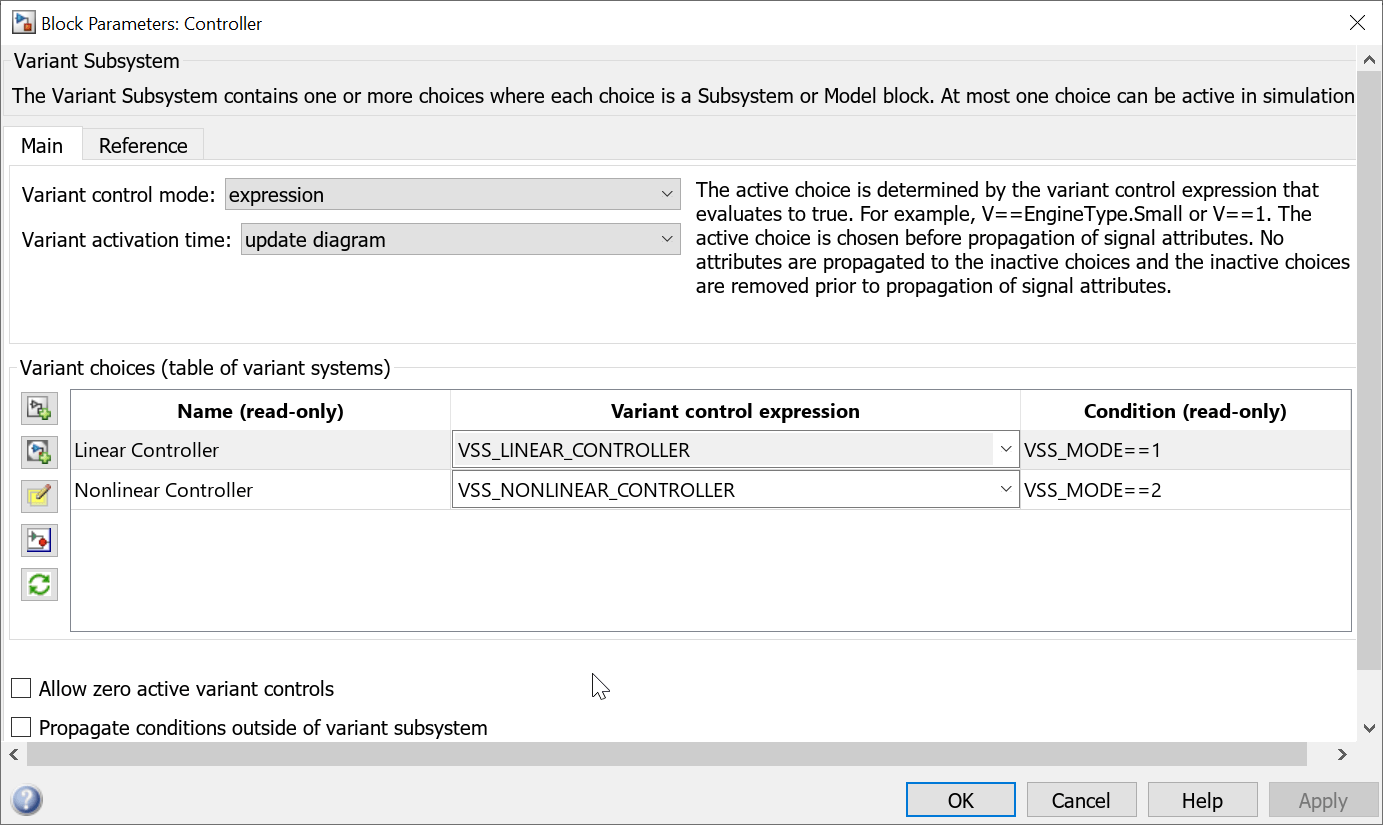このページの内容は最新ではありません。最新版の英語を参照するには、ここをクリックします。
バリアントのインライン コンポーネント
単一のレイヤーで構造のバリエーションを実装
インライン バリアント ブロックを使用して、システムのすべての代替設計を単一のモデルで表現できます。設計の選択肢は、それぞれバリアントの選択として単一のレイヤーでモデルに組み込まれます。このようなモデルには、共通の固定構造と、バリアント制御に応じてアクティブまたは非アクティブになる可変コンポーネントの有限セットがあります。コンポーネントは自動または手動でアクティブにできます。
たとえば、自動車のワイパーの速度を制御するモデルをさまざまなレイン センサーを使用してシミュレートするとします。レイン センサー モデルを Variant Source ブロックに入力として提供し、それらのセンサーをバリアント制御の選択に基づいて切り替えることができます。詳細については、バリアント制御の紹介を参照してください。
インライン バリアント ブロックの生成コードには、システムのすべてのバリアントの選択を含めることができます。Activate Variant During Different Stages of Simulation and Code Generation Workflowで説明されているように、コードのコンパイル前やモデルの起動時に選択を切り替えることができます。インライン バリアント ブロックのコード生成の詳細については、バリアントの構造 (Simulink Coder)を参照してください。
ブロック
| Variant Source | バリアントを使用した複数の入力間での経路指定 |
| Variant Sink | バリアントを使用した複数の出力間での経路指定 |
| Variant Start | Define start of bounded region (R2024a 以降) |
| Variant End | Define end of bounded region (R2024a 以降) |
| Manual Variant Source | 入力での複数バリアント選択肢の切り替え |
| Manual Variant Sink | 出力での複数バリアント選択肢の切り替え |
クラス
Simulink.VariantControl | Create a variant control variable object (R2021a 以降) |
Simulink.Parameter | パラメーター値の保存、共有、構成 |
Simulink.VariantExpression | バリアント選択を制御する条件を指定 |
Simulink.VariantUtils | Utility methods to work with variant elements (R2023b 以降) |
関数
enumeration | クラスの列挙型メンバーと名前 |
オブジェクト
struct | 構造体配列 |
トピック
バリアントの接続元信号と接続先信号の自動選択
- バリアント ソースとバリアント シンクの定義と構成
インライン バリアントを使用してバリアントの選択を表現します。 - 単一レイヤーでのバリアント実装の可視化
インライン バリアントを含むモデル内でバリアントの選択を表示します。 - Variant Control Modes in Variant Blocks
Learn how to control variant blocks. - Propagate Variant Conditions to Define Variant Regions with Variant Blocks
Determine active model components by propagating variant conditions using variant blocks. - Variant Source ブロックと Variant Sink ブロックを使用した、バリアント領域を定義するためのバリアント条件の伝播
Variant Source ブロックと Variant Sink ブロックからバリアント条件を伝播する。 - Propagate Variant Conditions to Control Execution of Conditional Subsystems
Understand how to use Variant Subsystem blocks with conditionally executed systems as variant choices. - Control Variant Condition Propagation using Variant Start and Variant End Blocks
Confine variations to a set of blocks and control their activation collectively using Variant Start and Variant End blocks.
バリアントの接続元信号と接続先信号の手動指定
- Manual Variant Source ブロックと Manual Variant Sink ブロックを使用した信号のソースと接続先での変化の提供
この例では、インライン バリアント ブロックManual Variant SourceとManual Variant Sinkの使用方法を示します。
トラブルシューティング
モデルをバリアント システムに変換 (Simulink Check)
モデル トランスフォーマー ツールを使用した、モデルのバリアント システムへの変換。

